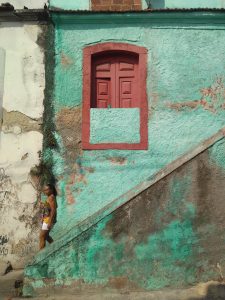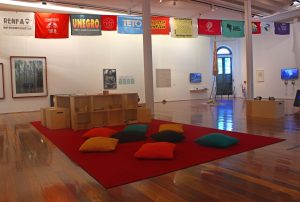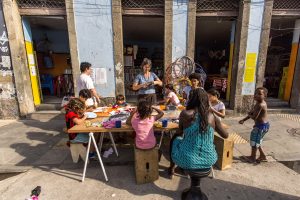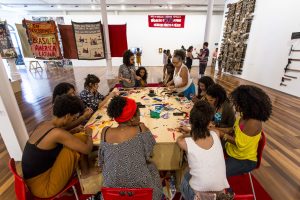There are certain questions that persist: how do you start conversations about artistic practices originating from the transatlantic diaspora, in an art scene which does not yet recognise the fabric and dynamic of these practices as art? How do you explain that certain creative techniques cannot be reduced to an object-oriented logic? Without the cluster of relational, cultural and spiritual connections that guide them, the products of such techniques cannot fully resonate with all of their potential.
These were some of the main challenges that arose when we created the engaged collective Amò to develop the Public Politics project, following an invitation to hold an exhibition in the Museu de Arte do Rio (Rio Art Museum) between 2018 and 2019. The Rio Art Museum had been built in the port area of central Rio in 2013, as a result of the regeneration that took place to prepare for the 2014 World Cup. The area in which the Rio Art Museum is located is known as Little Africa (Pequena África) and is made up of quilombola communities from Pedra do Sal and Santo Cristo, the Valongo Wharf (Cais do Valongo, a UNESCO World Heritage site), and the descendants of communities who survived the transatlantic slave trade in the Gamboa, Saúde neighbourhoods and those that surround them. It is also an area where migrants from communities with similar origins from other regions of Brazil, such as the North East, as well as the Caiçaras (of mixed indigenous, European and African heritage) from the coastal region of the state of Rio, have settled.
Our project involved listening to the inhabitants of this district. In looking at processes of cultural and community artistic creation, the choice of Little Africa was strategic. The dynamic produced by these inhabitants does not reduce individual memories to statues, nor does it reduce collective memories to a touristic, spatial circuit to be contemplated and explained. It is a place where a dialogue between ancestral memories and the construction of new imaginaries about the daily life of the transatlantic diaspora in Brazil is continually being produced.
In this context, we proposed a project in (and for) the region of Little Africa, one that used the museum space but did not make it the primary focus. This decision was taken for a number of equally important reasons: a) this area in Rio has an important heritage of cultural and creative practices and of community knowledge, along with that of other Afro-descendant territories; b) the museum’s existence in the context of the gentrification project of Little Africa; and c) the discussion around censorship in Brazilian art, involving many levels of debate.[1]
The 2014 Olympic Games in Brazil brought projects seeking to regenerate the port areas, but which, in reality, encouraged the forced removal of people or the so-called expulsão branca (white expulsion) – the strategy of raising rent prices so that Afro-descendant populations could not afford to stay in the area. This strategy of gentrifying black neighbourhoods has become a new form of contemporary colonisation.
 Ana Lira, Casa Machado de Assis, 2018–2019. Public Politics / Política Pública. Courtesy of artist.
Ana Lira, Casa Machado de Assis, 2018–2019. Public Politics / Política Pública. Courtesy of artist.
The building of the Rio Art Museum and the neighbouring Museu do Amanhã (Museum of Tomorrow)[2] were acts of cultural compensation offered by the Little Africa gentrification project. The museums were envisaged as having a public mission of dialoguing with the area’s cultural legacy by including diverse collaborative artistic practices in their exhibitions. Nevertheless, collaborative artistic projects like ours have been given less and less space in the museum, except when they are seen to have an educational role.
The debate over the Rio Art Museum’s strategic programming has intensified due to current cultural policy in Brazil. Funding for public museums is now used as a means of censoring works that are exhibited. This situation took on a new dimension when recently-formed right-wing movements brought together groups to monitor exhibitions and artists, and used social networks to create campaigns against cultural projects that are considered to be ‘outside of the norm’.[3]
In response to the attacks, one part of the Brazilian art scene decided to record a video including individuals from different cultural sectors, calling on the Brazilian population to open their eyes to what was happening.[4] The artists were here clamouring for the recognition and legitimisation of freedom of speech in Brazil. The video was shared widely and generated a great deal of debate, with the group going on to produce other videos to better clarify the purpose of the campaign.
Cultural practitioners and critics in Brazil failed to consider that you cannot imply that a population suffers from cultural blindness, especially when more than 60% of it is descended from the black diaspora and from indigenous Latin Americans who, over the course of history, have had their cultural heritage and creative processes appropriated into modern and contemporary art around the world. How can respect plausibly be called for, when at the same time, artistic, creative and exhibition practices do not recognise these other creative actors? Such actors assume the role of contemplative observers, in front of a sign reading ‘do not touch the artwork’. Is there an assumption that there is a separation of practice between ‘I conceptualise, I am an artist – whereas you are an artisan’?
In some museum spaces in Brazil, there is still resistance towards an understanding of creative practices that are not object-oriented, or designed for contemplative exhibition, as art. Frederico Morais carried out some highly relevant work in this respect, in the Museum of Modern Art in Rio de Janeiro in the 1970s. He invited a series of artists to put together proposals that could be developed through the participation of the visiting public. In challenging the assumption that creation is the sole privilege of the artist, these participatory events were revolutionary, but were not accepted by art critics. The projects proposed by Morais – which included artists who are still seen as subversive today and experiences such as Creative Sundays (Domingos da Criação)[5] – were published in a booklet entitled Cidades e Cotidiano (Cities and Daily Life), but were omitted from the culture guides, which contained the programme of art events.
Our exhibit at Rio Art Museum contributed to this discussion by refusing to divide artistic and participatory roles. We looked at diverse sources of creative syntheses, and at their processes, and treated them as having equal importance, within and outside of the museum. We bolstered our offering with lived experiences from different Brazilian cities in which the art market, with its object-oriented logic, does not set the rules for creative practices – and where the relationships between agents are freer and less hierarchical.

Installation view of Public Politics / Política Pública, Museu de Arte do Rio (Rio Art Museum). Courtesy of Amò Coletivo.
We also looked at experiences in other countries, where the term ‘artist’ is being replaced by ‘creative’ in order to include other forms of expression. We also understand that one of the reasons why these experiences are being valued is that part of the art scene has realised that artistic creation is more encompassing and sustainable even economically, than the idea of ‘art for art’s sake’, such as the one which still persists in Brazil’s largest cities.
As artists and researchers coming from collective contexts, with broad trajectories and experiences in diverse areas of the cultural sector, we did not want to operate in a creative space with a gulf between context and materialisation; one in which the fractures in these relationships open up spaces for all kinds of co-opting of ideas. We came from families who created carnival blocks, ran terreiros (yards where Afro-Brazilian religious traditions such as Candomblé are practiced), played in Samba schools, migrated between regions, worked in trade, industry, textile production, scientific research and in the arts. At the same time, our families developed educational traditions and discussed collective rights, migration and territoriality in their respective regions. We have a vision of the collective and creative process which does not allow us to restrict the breadth of our practice to the production of isolated objects that exist to be contemplated.
For this reason, we coordinated the artistic activities that make up Public Politics in the Little Africa area, and in dialogue with the museum – not the other way around. The project involved living alongside the inhabitants for almost a year, with the aim of listening to how they, their families and communities produced community-based knowledge. These listening exercises were not formal interviews, but the result of experiences of daily life in the district and through working on artistic projects.
The listening exercises materialised as a result of creative syntheses such as: games, culinary experiences, courses, publications, walks, film screenings, the Cosme e Damião (syncretic religious) celebrations, hugs, the production of images, interviews, mappings, experiences of sound, internal journeys, mementos, music, poetry kites, abayomis (an Afro-Brazilian popular art form consisting of handmade dolls), pottery, and the creation of a micro-reference library, among others. We developed partnerships with groups and other movements that we know, such as the Slam das Minas RJ team (an art collective who organise a travelling poetry contest in the state of Rio de Janeiro), and the members of the female art collective Aberta Residência. These groups responded to our invitation, leading to a publication containing the work of poets, writers, and visual artists from the region. Two local bars, Bar Delas and Bar da Jura, also opened their doors for collective creative practice sessions for children.
The children who came to the workshops were essential in fostering links with the collective spaces. They opened up pathways that allowed us to reach their parents and grandparents, and to dialogue with them. They also taught us to look at the cultural processes that were being passed on from one generation to the next, and those that were being transformed and/or abandoned in favour of other forms of creative practice and materialisation.
In many ways, the results of these listening exercises served to build a strategy of existence which passed, literally, though the hands of people who dialogued with us, both in neighbourhood-based activities and in the space that we designed for our exhibit in the museum. This included a collective welcome space, allowing access to a synthesis of materials and inviting visitors to get to know Little Africa itself, our own interactions and those of other cultural actors. People were invited to move, listen to, touch and reorganise our exhibit.
Listening to the inhabitants of the area generated a different dialogue to that of passing visitors or those who commute to Little Africa just to work – creating, with their presence, other imaginaries for the local community. On the other hand, the traces left by the visitors and teachers, as well as the experience of mediating between our working methods, the space and the museum staff, took us beyond our initial project. We filled the exhibition area with furniture that we designed, and which reflected the initial result of our listening exercises in the area. We thought about the space and about providing a table to host people so that they could engage in dialogue, experiment with creative processes and carry out research, amongst other things. We also set up a community knowledge library and an open area with cushions, where different kinds of encounters, arranged by us, the inhabitants, or the visitors, could take place.
 Abayomis Workshop, 2018–2019. Public Politics / Política Pública, Museu de Arte do Rio (Rio Art Museum). Courtesy of Amò Coletivo.
Abayomis Workshop, 2018–2019. Public Politics / Política Pública, Museu de Arte do Rio (Rio Art Museum). Courtesy of Amò Coletivo.
Our experiences within the museum broadened our reflections on the directions of our own work. Students from state schools, as well as operational and office staff from the museum, often visited our exhibit in order to use the welcome area as a place to rest. They lay down, slept, hung out, mingled together in piles of people, cushions and carpet, generating a new layer of meaning.
This space gave shape to the idea of resting Afro-descendant and peripheral bodies as public politics. Their bodies, pressured by daily experiences of harassment or by fatigue caused by their jobs, found a retreat in this space, a place to catch their breath. We looked at other approaches to artistic practice, reflecting on celebration and rest as a creative process pathway.
Since our space was one of the few within the museum that was open for people to express themselves directly, visitors left different reflections, messages and statements about Brazilian politics, feminisms, education, creative practice, and emotional outbursts about their daily struggles. They scratched the furniture, stuck materials together, interfered with the artists’ portfolios and took with them the only copy of our book of dreams.
This disruption of the ‘ownership of the work of art’ prompted the entire museum team to reflect. The staff supported us and also had important conversations with us. However, the museum was already finding it challenging to cope with our presence, because we were allowing people to touch and interact with the exhibit. They suggested that we secure the results of our listening exercises with steel wire in order to prevent them from disappearing.
Our response was to say no and to incorporate intervention/interaction – whether supportive or critical of the debate around diasporic art practices – into a process of ‘listening maps’ that we were undertaking. The map sought to integrate the impressions of those who occasionally visit the area into the experiences that we were having with the inhabitants.
We also noticed that these interactions created tension around the model of the exhibition itself. Yes, on the one hand, the content produced by the artists invited people to look at collective revolutions and generated diverse feelings among the visitors. Yet on the other hand, so as to respect the new exhibition politics of 2018–2019, our display in the museum had to be set up almost entirely from the perspective of contemplation.
The museum had hoped that responses from the public would be expressed through official channels: on the walls, in educational sessions or on social media. By not being able to calculate the disorder factor of visitor participation, our space served to display the contents of reflection or revolt left by visitors each day. This aspect demonstrates that our way of working engages with other dynamics and that we are attentive to the pathways that are uncovered in developing these activities.
The result of this experience transformed our understanding of listening exercises. Questions arose such as: What is a body that listens? What is a listening body?
We concluded that a body that listens is one that is available for an interaction with someone involving listening, whether or not it constitutes a dialogue. Whereas a listening body is a body that is a channel, able to engage with both present and metaphysical energies, with the aim of relaying messages that need to circulate in the context of learning from black diaspora communities.
These questions have arisen from the community knowledge that we discovered through this experience. If tension had not been created in our relations with the museum, we would probably still be contending with the questions we put forward at the beginning of this text. Public Politics was a learning experience for all of Amò Colectivo, in terms of discovering artistic potentialities, community co-responsibility, and understanding that interlacing artistic creation with ancestral memory also requires the spiritual dimensions of our processes to be tackled.
Amò was a strategy that we created to develop these activities. Now, we continue, as artists and processes, with other proposals for collaboration. This experience was essential in consolidating and realigning our connections with unfractured creative practices.
